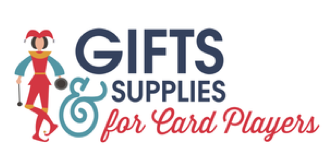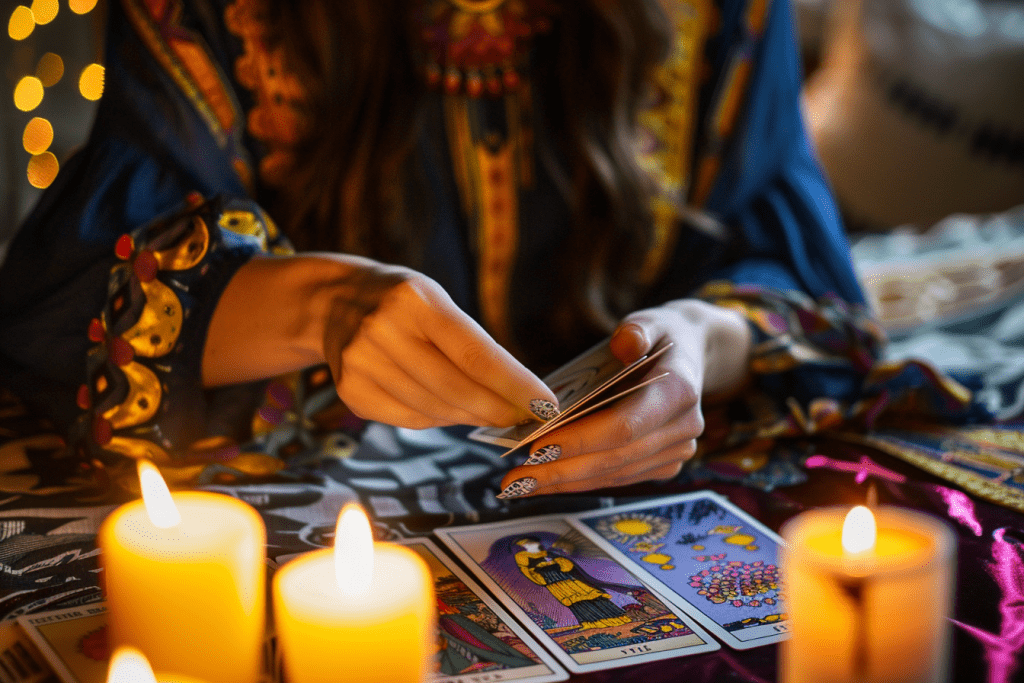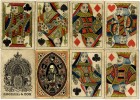What is a Cartomancer?
Alex J. Coyne © Gifts for Card Players 2024
A cartomancer is a person who practices cartomancy, which is the practice of fortune-telling or divination using a deck of cards. This can include standard playing cards, tarot cards, or any other specialized decks designed for divination. Cartomancers interpret the meaning of cards to provide insights or predictions about a person’s life or future. In this article we look at cartomancy, where it began, how it works, and how you can learn more about the art.
Cartomancers are also called card readers. It applies to anyone who uses random spreads of cards, tarot or traditional ones, to interpret their order and meanings. A cartomancer attributes individual meanings (usually traditional ones) to each card, and interprets the order in which they’re drawn from the deck.
How does it work?
Cartomancy has been used for thousands of years, though it’s more commonly called card (tarot) reading. The term ‘tarot reader’ or ‘card reader’ are much more common than ‘cartomancer’ but they all do the same thing.
In essence a reading works this way – a person will come to a cartomancer with a question in their hearts and minds. It might be something specific, or something more general. Classic questions are often about the future, or fate, of a person or enterprise.
The cartomancer will then deal the cards in a prescribed pattern and determine an answer. Most cartomancy answers are general, as most fortune telling deals in ‘potential’ rather than absolutes. But it is possible to request a ‘yes or no‘ reading. In fact, the more specific a question is, the more clear the reading will be.
Cartomancy is known as an ‘occult’ science. The term “occult” means “hidden” or “secret,” and occult sciences seek to understand and manipulate forces beyond the realm of conventional scientific understanding. Other occult sciences are palmistry, astrology, numerology, i ching, and runes. All employ a knowledge of patterns that is thousands of years old.
The best explanation at this time can be found in the phrase, “As above, so below.” This expresses the idea that there is a correspondence between different levels of reality, such as the macrocosm (the universe) and the microcosm (the individual). This teaching suggests that understanding the higher, universal principles can provide insight into the lower, earthly ones, and vice versa.
To date, modern science has not been able to explain how and why these practices seem to work, however recent results from the world of quantum physics suggest the answer may be revealed soon.
How old is cartomancy?
Cartomancy, the practice of using cards for divination, has its origins in the late 14th century when playing cards first appeared in Europe. The exact origins of the use of cards for divination are not clear, but by the 18th century, cartomancy had become a well-established practice in various parts of Europe. Tarot cards, one of the most popular tools for cartomancy, were developed in the mid-15th century, originally for playing games, but were later adapted for divinatory purposes.
Cartomancy isn’t as old as many other divination practices, having come onto the scene only after the appearance of playing cards. Early cards were often hand-painted, making them relatively expensive and accessible primarily to the wealthy. The cards were sometimes reinforced with a layer of glue or varnish to make them more durable.
References to using playing cards for divination begin to appear in Europe in the 16th century. Divination with cards likely evolved from earlier methods of sortilege (casting lots). With sortilege, divination typically involves throwing or drawing lots, which could be small objects like stones, sticks, bones, or marked pieces of wood or paper. The interpretation of the outcome depends on how the items fall or are drawn. Sortilege is one of the earliest known forms of divination and has influenced many other divinatory practices, including cartomancy. You can find mention of sortilege in the Bible, one of the oldest written records, dating back thousands of years.
As one of the earliest known forms of divination, sortilege and has influenced many other divinatory practices, including cartomancy. Other examples are runes, i-ching coins, and dice
The actual word “cartomancy” is a combination of the Latin word “carta’ (paper), and the Greek suffix ”-mancy” for divination.
Other, similar divination forms use the same naming convention.
For example, “bibliomancy” is divination using books, chiromancy (reading palms, and belomancy (reading arrows). There are many other types of divination, but most of them are named in the same way. Even astrology is called astromancy, a term that refers to the practice of divination through the study of celestial bodies
Does everyone read cards the same?
There are many different ways to interpret the card meanings but over time tarot (and playing cards) have developed agreed upon meanings. Cartomancer practitioners will use standard card interpretations and it’s also recommended that people just starting out with the art should learn the traditional meanings for each card as well. There are some readers, however, who simply use the cards to inspire intuitive interpretations and divinations. These practitioners would be called psychics more often than cartomancers.
As a note for newcomers, some cartomancers embrace “reversed” (upside down) meanings, while some readers don’t use them at all.
Card meanings are usually interpreted around “archetypes”, or famous figures that could have similar meanings in many cultures – like the Royal or Court cards in tarot and traditional playing card decks. The importance of the cards’ illustrations, which are typically full of symbols and meaning, is a big part of cartomancy but of course, if you’re using a basic deck of playing cards, you’ll read mostly the pips.
How you can learn cartomancy
The best way to learn anything is by reading a book about it and there are hundreds of great books about cartomancy if you want to know more. Here are five simple suggestions for learning more about cartomancy:
- Cartomancy: Fortune Telling with Playing Cards
- The Cartomancy Workbook
- Tarot 101
- Cartomancy by Luke Germay
- Let’s Try Cartomancy
You can also find simple card reading courses on learning platforms like EdX and Coursera. Some of these courses are free, and teach you different ways to interpret or “read” the cards.
Professional card readers also list their courses, and you might also be able to learn from an experienced card reader.
A good book that gives you a basic interpretation of the cards is the place to start. There are also ‘patterns’ to how the cards are dealt, such as the Celtic Cross, the Three-card Spread, and the Five-card Spread. So be sure these are also included in your first book. In fact, many decks of tarot cards come with a book to help with your divinations.
You’re in for a treat
Tarot and other decks designed for cartomancy are some of the most beautiful art in the world. On our sister site, Gifts for Mystics, you will find many beautiful decks. And if you’re interested in learning cartomancy with a regular deck of cards, you’ll want to view some of the lovely decks on our Playing Cards page!





